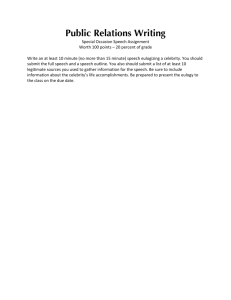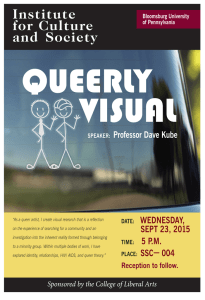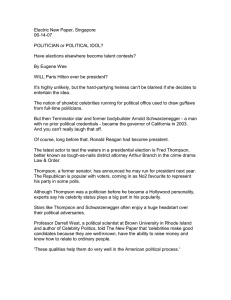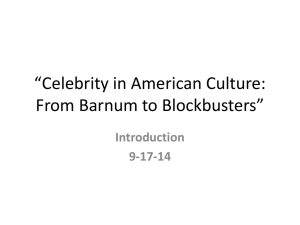LGBT 599: Queer Stars and Celebrities Course Description Spring 2016
advertisement
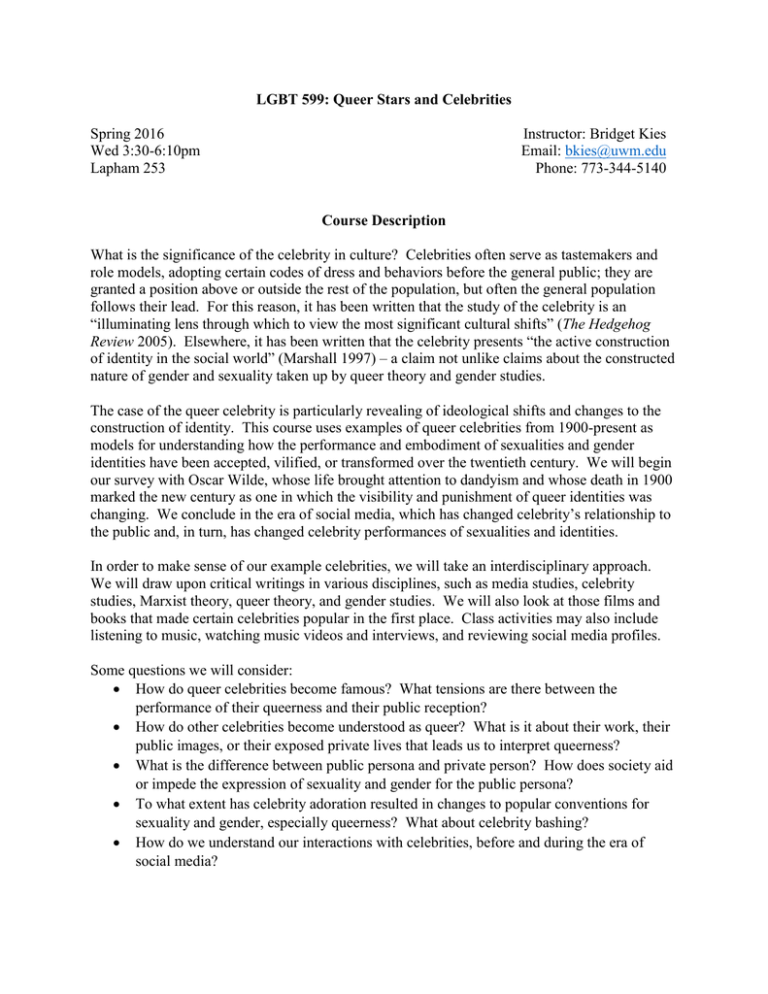
LGBT 599: Queer Stars and Celebrities Spring 2016 Wed 3:30-6:10pm Lapham 253 Instructor: Bridget Kies Email: bkies@uwm.edu Phone: 773-344-5140 Course Description What is the significance of the celebrity in culture? Celebrities often serve as tastemakers and role models, adopting certain codes of dress and behaviors before the general public; they are granted a position above or outside the rest of the population, but often the general population follows their lead. For this reason, it has been written that the study of the celebrity is an “illuminating lens through which to view the most significant cultural shifts” (The Hedgehog Review 2005). Elsewhere, it has been written that the celebrity presents “the active construction of identity in the social world” (Marshall 1997) – a claim not unlike claims about the constructed nature of gender and sexuality taken up by queer theory and gender studies. The case of the queer celebrity is particularly revealing of ideological shifts and changes to the construction of identity. This course uses examples of queer celebrities from 1900-present as models for understanding how the performance and embodiment of sexualities and gender identities have been accepted, vilified, or transformed over the twentieth century. We will begin our survey with Oscar Wilde, whose life brought attention to dandyism and whose death in 1900 marked the new century as one in which the visibility and punishment of queer identities was changing. We conclude in the era of social media, which has changed celebrity’s relationship to the public and, in turn, has changed celebrity performances of sexualities and identities. In order to make sense of our example celebrities, we will take an interdisciplinary approach. We will draw upon critical writings in various disciplines, such as media studies, celebrity studies, Marxist theory, queer theory, and gender studies. We will also look at those films and books that made certain celebrities popular in the first place. Class activities may also include listening to music, watching music videos and interviews, and reviewing social media profiles. Some questions we will consider: How do queer celebrities become famous? What tensions are there between the performance of their queerness and their public reception? How do other celebrities become understood as queer? What is it about their work, their public images, or their exposed private lives that leads us to interpret queerness? What is the difference between public persona and private person? How does society aid or impede the expression of sexuality and gender for the public persona? To what extent has celebrity adoration resulted in changes to popular conventions for sexuality and gender, especially queerness? What about celebrity bashing? How do we understand our interactions with celebrities, before and during the era of social media? Course Texts Most readings will be posted to D2L as PDFs. You will be asked to obtain copies of the following two texts, which we will read in their entirety: Kaufman, Moises. Gross Indecency: The Three Trials of Oscar Wilde (Acting Edition). New York: Dramatists Play Service, 1999. ISBN-13: 978-0822216490. Kaufman, Moises. The Laramie Project (Acting Edition). New York: Dramatists Play Service, 2001. ISBN-13: 978-0822217800. Course Schedule Each week, we will study a different star or celebrity as we move through the twentieth century. We will study Oscar Wilde, Langston Hughes and jazz divas of the 1920s, Eleanor Roosevelt, Greta Garbo, Marlene Dietrich, Marilyn Monroe, James Dean, Judy Garland, Andy Warhol, David Bowie, Freddie Mercury, Adam Lambert, Ellen DeGeneres, Neil Patrick Harris, and Lady Gaga. The list of readings and celebrities may vary as the syllabus is finalized or as class interest warrants.
